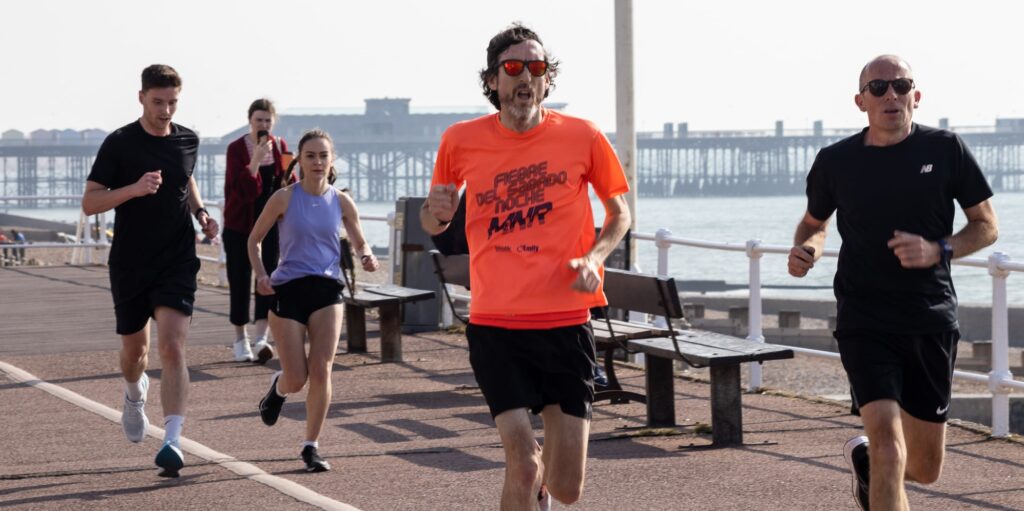With race season upon us, I wanted to share my thoughts on race strategies. This only really applies to runners who are targeting a specific time for your chosen race.
Once you’ve selected a goal race it’s time to consider your target time. This will primarily be determined by your training in the build up to the race. Be sensible and consider how well you’ve been running the required distance in the months preceding race day.
When you know your target time you can quickly calculate how fast you need to run each kilometre or mile. I prefer to work in kilometres and there is a good reason for this. I’ll explain later.
Repeatedly looking at your watch isn’t really a viable option in a race, but Garmin’s like to vibrate when we complete a km or mile, thus giving us data to how we are performing in relation to our goal pace.
Just this weekend I ran the Paddock Wood half marathon (I’m sure you know that by now) and was striving for a new PB. To achieve that goal I knew that I needed to average 4:36 per km for the entirety of the race.
The first part of the race is key and can often be the hardest to get right. Generally 80% of the field will start too fast and it’s easy to get carried away. There is also the chance of crowding at the beginning which could slow you down. So if you have experience of the race you might want to factor this in to your strategy.
Keep a close eye on your pace for the first 500 meters to make sure you are running the speed you want to. My first glance at Paddock Wood showed 5:00 per km, so I quickly had to adjust.
In the end my first kilometre was 4:30 so I was quickly able to calculate that I’m 6 seconds under goal pace. Km 2 through 4 were 4:32, 4:30, 4:33. So now I’m 19 seconds ahead of goal pace.
My race strategy is always to refrain from going off too quickly. If you run out of energy with 25% of the race still left, it’s a horrible experience. If you conserve your energy in the early part of the race and finish strongly, it’s much more enjoyable.
Despite being under goal pace, the first 5km of my half marathon I would estimate 60-70 runners over took me. But I knew I needed to hold back and not make that mistake of going too fast, too soon.
As the race progressed my speed inevitably dropped. Kilometre 14 (4:40), Km 16 (4:40), Km 18 (4:42). Uh oh. But this is where this approach pays dividends. I knew I was still 8 seconds ahead of schedule and really gave myself a good talking to and found some extra energy.
Back to the reason I like to work in kilometres rather than miles. It’s the more frequent data that we receive during the race. When my watch beeped at kilometre 18 at 4:42 I knew I had to quickly respond. If you’re working in miles then that dip in speed might prove more costly, as by the time you realise your pace has dropped off, it’s too late to react.
On this occasion I had enough energy left over to run the final 3 kms in 4:33, 4:30 and then 4:14, resulting in a new PB. Had I not kept track of my pace throughout the race I am convinced I would have gone off too fast and struggled to maintain that speed. A mistake I actually made at Paddock Wood 2 years earlier. I was so deflated that day and the last 5km were pure misery.
So, you’ve picked a race, you know your target time and you’ve calculated the average pace you need to run. What next?
Well the route needs careful consideration. If it’s undulating like Hastings then the chances are the variance in your speed will be high. But if you plan your strategy before the race, you should have an idea of how far behind or ahead of goal pace you will be at key stages of the route.
I’ve actually done a race strategy specifically for Hastings Half Marathon which breaks down each kilometre of the race and how you can expect your pace to vary. At the 14km mark I would predict you’ll be at least one minute behind goal pace. This is a lot of time to make up, but if you’ve trained well and picked a realistic target time, you can make up that in the final section of the race.
I realise this might be a lot to digest, but it’s an approach which has worked well for me and as someone that enjoys analytics and numbers, calculating my pace in relation to my target time during the event is actually good fun.
I offer race strategy to all my runners on training plans, unique to them and their goals. If this is something that sounds interesting to you, then get in touch and join the Team🍊.








